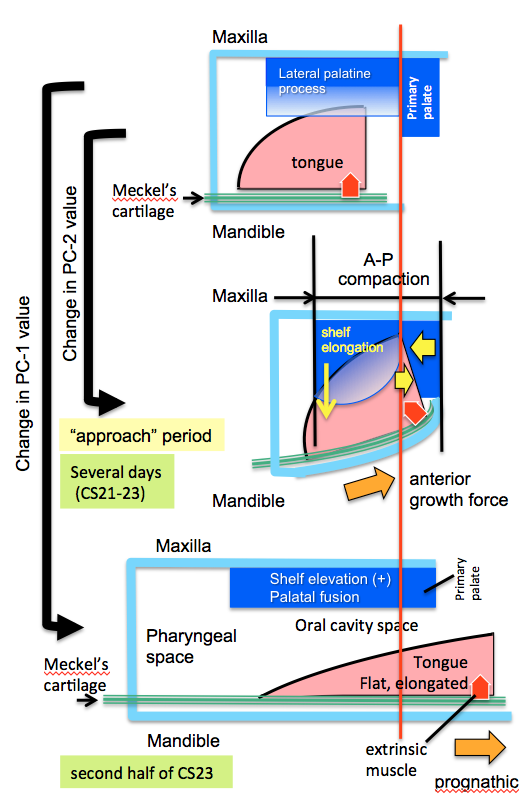
野原さんの修論がJ Anatomyに掲載されました。
胚子期末の2次口蓋形成時の舌、口蓋だな、下顎(メッケル軟骨)、鼻腔の動きを主成分分析等を用いて解析し、口蓋だな上昇、融合前の数日間の下顎(メッケル軟骨)、舌が極度に前後に圧縮される時期を”approach period”として見出しました。
- 口蓋棚の上昇・癒合はCS23中におきる。
- 「アプローチ期間」の間、下顎骨 (メッケル軟骨と舌) と上顎骨 (口蓋と鼻腔) の構造は位置を変えなかったが、構造の両方のグループが前後に圧縮されていた。
- 口蓋棚上昇前後では、上顎と下顎の構造、特に舌の上の棚の配置、および舌と下顎骨の突出の間に有意な変化を示した。
- これらの結果は、メッケル軟骨の成長が舌を再配置して棚の上昇を促進する上で積極的な役割を果たしていることを示唆している。
ヒトの二次口蓋閉鎖の 3 つの異なるPhaseを表す現在のデータは、口蓋棚の水平配置の前後に発生する形態学的成長変化と、ヒトの二次口蓋をうまく閉じるためのそれらの融合の理解を進めることができます。
Nohara A, Owaki N, Matsubayashi J, Katsube M, Imai H, Yoneyama A, Yamada S, Kanahashi T, Takakuwa T. Morphometric analysis of secondary palate development in human embryos. J Anatomy, 2022, 241(6), 1287-1302, 2022, DOI:10.1111/joa.13745
Abstract
Rapid shelf elevation and contact of the secondary palate and fusion reportedly occur due to a growth-related equilibrium change in the structures within the oro-nasal cavity. This study aimed to quantitatively evaluate complex three-dimensional morphological changes and their effects on rapid movements, such as shelf elevation and contact, and fusion. Morphological changes during secondary palate formation were analyzed using high-resolution digitalized imaging data (phase-contrast X-ray computed tomography and magnetic resonance images) obtained from 22 human embryonic and fetal samples. The three-dimensional images of the oro-nasal structures, including the maxilla, palate, pterygoid hamulus, tongue, Meckel’s cartilage, nasal cavity, pharyngeal cavity, and nasal septum, were reconstructed manually.
palatal shelves were not elevated in all the samples at Carnegie stage (CS)21 and CS22 and in three samples at CS23. In contrast, the palatal shelves were elevated but not in contact in one sample at CS23. Further, the palatal shelves were elevated and fused in the remaining four samples at CS23 and all three samples from the early fetal period. For each sample, 70 landmarks were subjected to Procrustes and principal component (PC) analysis. PC-1 accounted for 67.4% of the extracted gross changes before and after shelf elevations. Notably, the PC-1 values of the negative and positive value groups differed significantly. The PC-2 value changed during the phases in which the change in the PC-1 value was unnaturally slow and stopped at CS22 and the first half of CS23. This period, defined as the “approach period”, corresponds to the time before dynamic changes occur as the palatal shelves elevate, the tongue and mandibular tip change their position and shape, and secondary palatal shelves contact and fuse. During the “approach period”, measurements of PC-2 changes showed that structures on the mandible (Meckel’s cartilage and tongue) and maxilla (palate and nasal cavity) did not change positions, albeit both groups of structures appeared to be compressed anterior-posteriorly. However, during and after shelf elevation, measurements of PC-1 changes showed significant changes between maxillary and mandibular structures, particularly positioning of the shelves above the tongue and protrusion of the tongue and mandible. These results suggest an active role for Meckel’s cartilage growth in repositioning the tongue to facilitate shelf elevation. The present data representing three distinct phases of secondary palate closure in humans can advance the understanding of morphological growth changes occurring before and after the horizontal positioning of palatal shelves and their fusion to close the secondary palate in humans successfully.







